

|
| DEUTSCHLAND | GERMANY |
| Bundesland: Hessen | Hesse |
| Regierungsbezirk: Darmstadt | |
| Stadt: Darmstadt |
Darmstadt is situated at an elevation of 144 m at the eastern edge of the Rhine rift in southern Hesse. The city of Darmstadt is the capital of the administrative region Darmstadt and of the district Darmstadt-Dieburg. With a population of about 138,600 (2005) darmstadt is the fourth-largest city of Hesse after Frankfurt am Main, Wiesbaden and Kassel.
It is supposed that the settlement was founded in the 8th or 9th century. The oldest document mentioning Darmundestat dates from the late 11th century. Eberstadt, today part of Darmstadt, had already been mentioned in 782 AD. Darmstadt was chartered as a town in 1330 and in 1369 became an independent parish. In 1385 the town became a a secondary residence of the counts of Katzenelnbogen. In 1479 it became Hessian when it was inherited by Landgrave Heinrich III of Hesse-Marburg. Landgrave Philipp I ('the Magnanimous') of Hesse introduced the Reformation in 1527. In 1526, during the War of Schmalkalden, Darmstadt was destroyed by Imperial troops. After the death in 1567 of Philipp I, Hesse was divided among his four sons and Georg I became the first landgrave of Hesse-Darmstadt. Darmstadt soon became a sizeable residence town. When Landgrave Ludwig X in 1806 joined the Confederation of the Rhine, Hesse-Darmstadt obtained the status of a Grand Duchy and Ludwig became the first Grand Duke of Hesse-Darmstadt and by Rhine (Ludwig I). In 1899 Grand Duke Ernst Ludwig invited seven joung artists (the architects Peter Behrens and Joseph Maria Olbrich, the sculptors Rudolf Bosselt and Ludwig Habich, the painters and illustrators Paul Bürck and Hans Christiansen, and the goldsmith and jewelry designer Patriz Huber) to come to Darmstadt and thus founded the famous Art Nouveau artists' colony at the Mathildenhöhe. In 2021, the Mathildenhöhe was inscribed in the UNESCO list of World Cultural Heritage Sites (see also list of other World Cultural Heritage sites depicted on glasses of this collection).
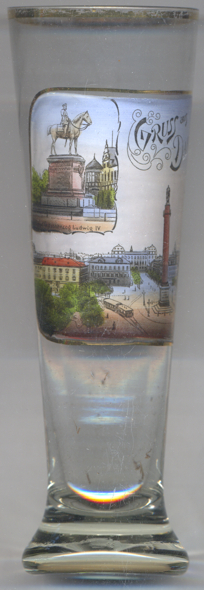
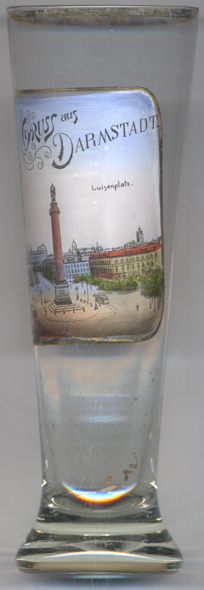
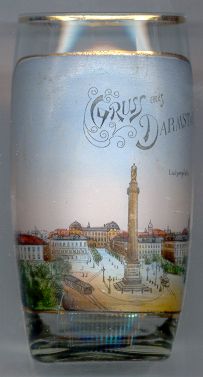 After World War I, Darmstadt in 1918 became the capital of the state of Hesse, which replaced the old grand duchy.
During World War II, in the night of the 11th September 1944, about 99% of the old town centre, about 78% of the
entire town were destroyed by a British bomb raid and the following firestorm. About 11,500 lost their lives and 66,000
became homeless. After the war the new state of Hesse was founded in 1946 and also included the territories of the former
duchy (later Prussian province) of Nassau, the Electorate of Hesse(-Kassel) (Prussian province
Hesse), and the former Principality of Waldeck (without Pyrmont).
Wiesbaden was chosen as the new capital.
After World War I, Darmstadt in 1918 became the capital of the state of Hesse, which replaced the old grand duchy.
During World War II, in the night of the 11th September 1944, about 99% of the old town centre, about 78% of the
entire town were destroyed by a British bomb raid and the following firestorm. About 11,500 lost their lives and 66,000
became homeless. After the war the new state of Hesse was founded in 1946 and also included the territories of the former
duchy (later Prussian province) of Nassau, the Electorate of Hesse(-Kassel) (Prussian province
Hesse), and the former Principality of Waldeck (without Pyrmont).
Wiesbaden was chosen as the new capital.
Glasses no. 1538 [right] and no. 3476 [left]show the square
 Luisenplatz,
Luisenplatz,
The  Ludwigsmonument was erected in the centre of the square in 1844 in memory of
Grand Duke Ludwig I (b.1753, acc.1790, d.1830). The architect was Georg Moller. The column has a height of 33 m.
The platform on top of the column beneath the statue of the grand duke can be reached by a spiral staircase in the interior
of the monument. The bronze statue was cast by the famous Ludwig Michael von Schwanthaler from Munich.
Ludwigsmonument was erected in the centre of the square in 1844 in memory of
Grand Duke Ludwig I (b.1753, acc.1790, d.1830). The architect was Georg Moller. The column has a height of 33 m.
The platform on top of the column beneath the statue of the grand duke can be reached by a spiral staircase in the interior
of the monument. The bronze statue was cast by the famous Ludwig Michael von Schwanthaler from Munich.
The building depicted in the far background is the
 Residenzschloss
Residenzschloss
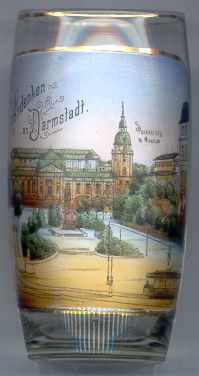
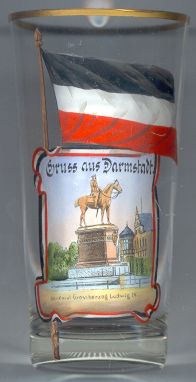
Glass no. 2013 [left] shows the square
 Paradeplatz
Paradeplatz
The  Hessian state museum [background] was built in 1897–1902
by the architect Alfred Messel. The museum was destroyed in 1944 and was restored until 1957. The central part
of the attic floor was remodeled in 1970.
Hessian state museum [background] was built in 1897–1902
by the architect Alfred Messel. The museum was destroyed in 1944 and was restored until 1957. The central part
of the attic floor was remodeled in 1970.
The  monument for Grand Duke Ludwig IV [right, no. 1910 and also
top left, no. 3476: top left inset],
situated also on Friedensplatz, was created by Friedrich Schaper and was unveiled on the 25th of November, 1898.
Ludwig IV was born in 1837 and was Grand Duke from 1877 until 1892.
monument for Grand Duke Ludwig IV [right, no. 1910 and also
top left, no. 3476: top left inset],
situated also on Friedensplatz, was created by Friedrich Schaper and was unveiled on the 25th of November, 1898.
Ludwig IV was born in 1837 and was Grand Duke from 1877 until 1892.
The building depicted in the background, far right [barely visible], is the former
 Hoftheater
Hoftheater
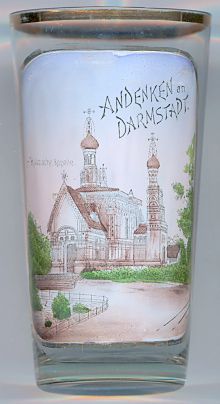
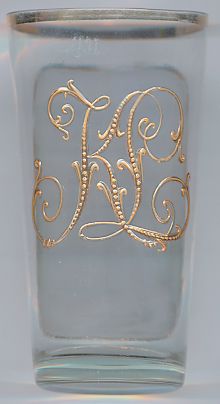
Glass no. 2391 [near left] shows the
 Russian Chapel.
Russian Chapel.
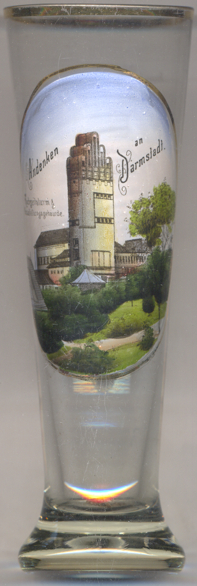
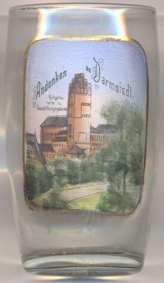
The  Hochzeitsturm ('Wedding Tower')
[left, no. 3477, and right, no. 3214]
on Mathildenhöhe is the popular landmark of Darmstadt. The 45-m-high tower was built in 1908 by the architect
Joseph Maria Olbrich as a present of the city of Darmstadt to Grand-Duke Ernst Ludwig and his wife Eleonore,
Princess of Solms-Hohensolms-Lich, to commemorate their wedding on 2 February 1905. The Art-Nouveau
brick construction with its characteristic five-part arched roof (hence its popular nickname 'Five-Finger-Tower')
is part of the complex of the then new water reservoir and the exhibition hall [background] of the
artists' colony.
Hochzeitsturm ('Wedding Tower')
[left, no. 3477, and right, no. 3214]
on Mathildenhöhe is the popular landmark of Darmstadt. The 45-m-high tower was built in 1908 by the architect
Joseph Maria Olbrich as a present of the city of Darmstadt to Grand-Duke Ernst Ludwig and his wife Eleonore,
Princess of Solms-Hohensolms-Lich, to commemorate their wedding on 2 February 1905. The Art-Nouveau
brick construction with its characteristic five-part arched roof (hence its popular nickname 'Five-Finger-Tower')
is part of the complex of the then new water reservoir and the exhibition hall [background] of the
artists' colony.
[https://de.wikipedia.org/wiki/Hochzeitsturm]
![[scale]](lineal.jpg)